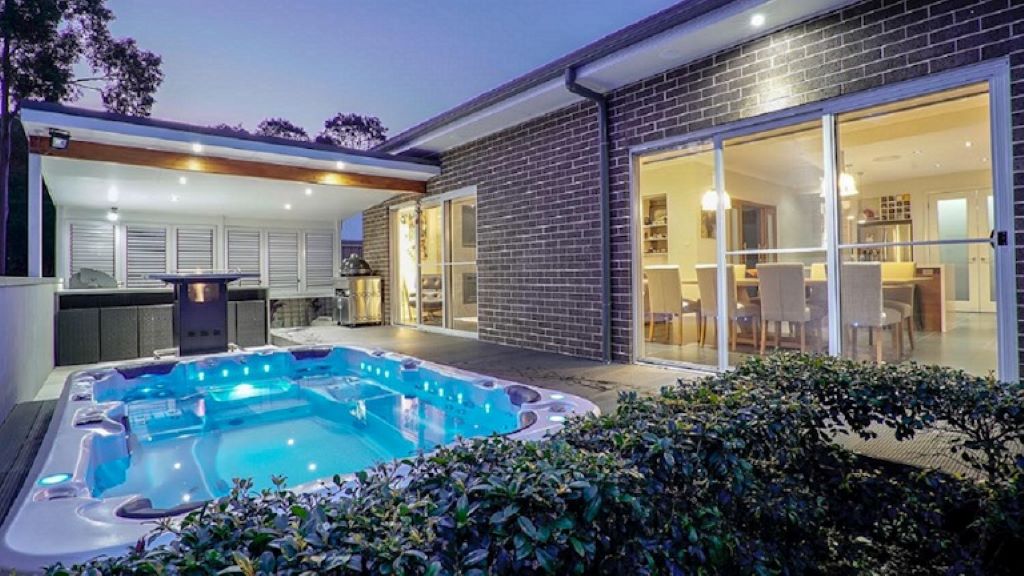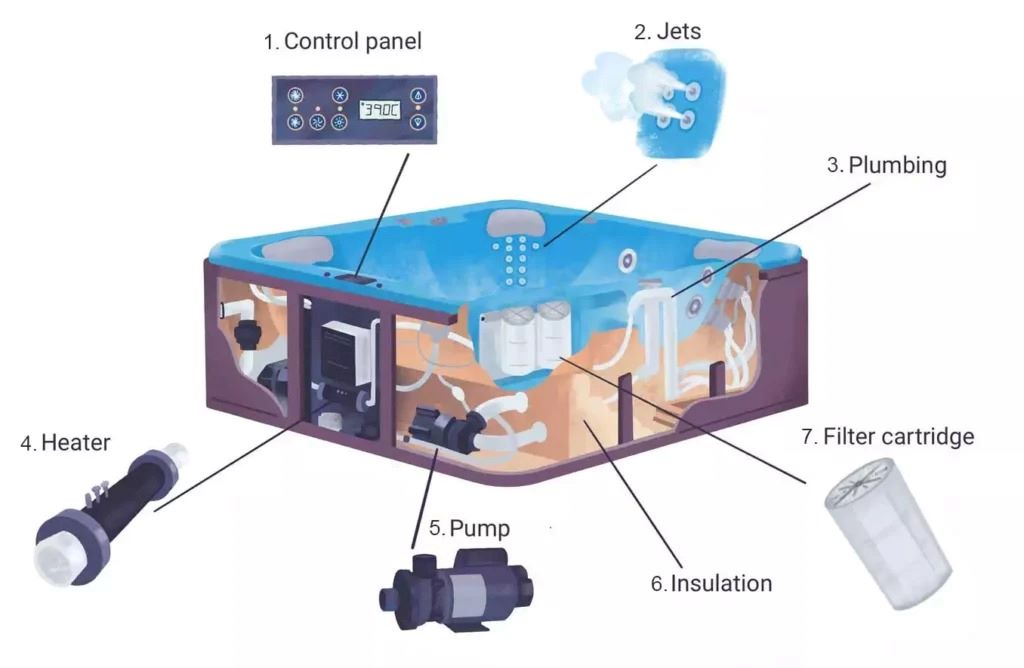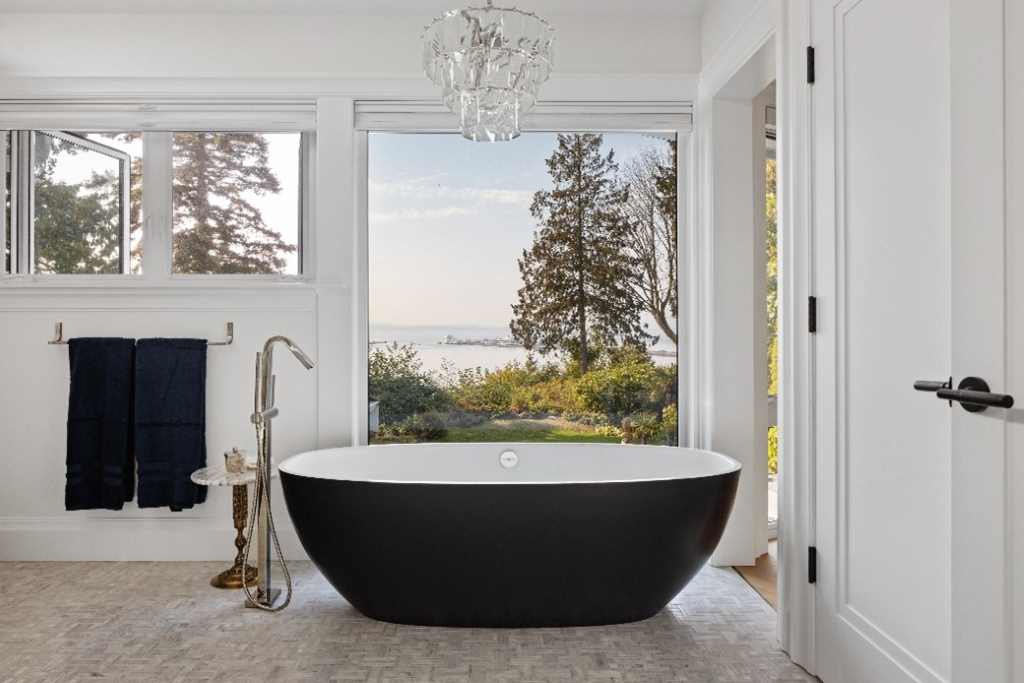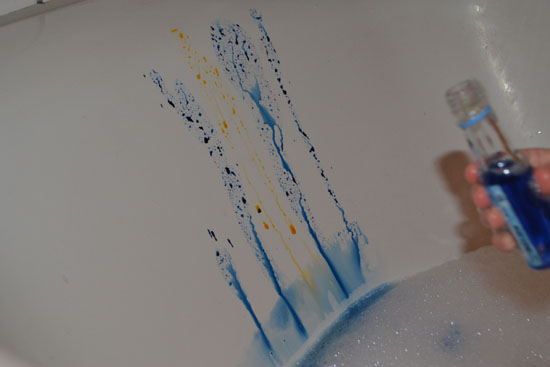The allure of a bubbling, warm jacuzzi hot tub is undeniable. It’s a sanctuary for relaxation, a place to soothe sore muscles, and a hub for social gatherings. But behind the serene surface lies a complex system of interconnected parts, each playing a crucial role in delivering that perfect soak. Understanding your jacuzzi hot tub parts diagram is essential for maintenance, troubleshooting, and ensuring optimal performance. This comprehensive guide will dissect the anatomy of your hot tub, answer common FAQs, and empower you to become a more informed owner.
The Core Components: A Jacuzzi Hot Tub Parts Diagram Breakdown
Let’s begin by dissecting the core components that make up a typical jacuzzi hot tub. While specific configurations may vary between models and manufacturers, the fundamental parts remain relatively consistent.
-
Shell and Cabinet:
- The shell, typically made of acrylic or fiberglass, forms the visible interior of the hot tub. It’s designed to be durable, waterproof, and comfortable.
- The cabinet, surrounding the shell, houses the mechanical components and provides insulation. Materials range from synthetic wood to composite panels.
-
Jets:
- These are the nozzles that propel water and air, creating the massaging action. Jet types include directional, rotary, and pulsating, each offering a unique therapeutic effect.
- The jet placement and configuration are crucial for targeted hydrotherapy.
-
Pumps:
- The heart of the hot tub, pumps circulate water through the filtration and heating systems.
- There may be one or more pumps, depending on the jet count and system complexity. Some tubs have dedicated circulation pumps for continuous filtration.
-
Heater:
- This component warms the water to the desired temperature. Electric heaters are the most common, utilizing resistance elements to generate heat.
- Proper heater maintenance is crucial for energy efficiency and consistent water temperature.
-
Filter:
- The filter removes debris and impurities from the water, ensuring cleanliness and clarity. Cartridge filters are commonly used, requiring periodic cleaning and replacement.
-
Control Panel:
- This interface allows users to adjust temperature, jet settings, lighting, and other functions. Modern panels often feature digital displays and touch-sensitive controls.
-
Plumbing:
- A network of pipes and valves connects the various components, facilitating water flow.
- Leak-free plumbing is essential to prevent water loss and damage.
-
Ozonator/UV Sanitizer (Optional):
- These systems provide supplemental water sanitization, reducing the need for chemical treatments.
- Ozonators generate ozone gas, while UV sanitizers use ultraviolet light to kill bacteria and viruses.
-
Air Blower (Optional):
- This component introduces air into the water, enhancing the jet massage and creating a bubbly effect.
-
Lightings (Optional):
- LED lights are commonly used to create ambiance and improve the hot tub experience.
Navigating the Jacuzzi Hot Tub Parts Diagram: Practical Applications
Understanding the diagram isn’t just theoretical; it has practical applications for hot tub owners:
- Troubleshooting:
- When problems arise, the diagram helps pinpoint the source of the issue. For example, a lack of jet pressure might indicate a pump or plumbing problem.
- Maintenance:
- The diagram clarifies the location of components requiring regular maintenance, such as the filter and heater.
- Repairs:
- If a part needs replacing, the diagram facilitates accurate identification and ordering.
- Upgrades:
- For owners seeking to enhance their hot tub experience, the diagram reveals potential upgrade opportunities, such as adding an ozonator or additional jets.
People Also Ask: Essential Jacuzzi Hot Tub FAQs
Let’s address some of the most common questions hot tub owners have:
-
Q: How often should I change my hot tub water?
- A: The frequency depends on usage and water chemistry. Generally, every 3-4 months is recommended. However, frequent use or high bather load necessitates more frequent changes.
-
Q: How do I clean my hot tub filter?
- A: Remove the filter cartridge and rinse it with a garden hose, removing loose debris. For a deeper clean, soak it in a filter cleaning solution.
-
Q: What chemicals should I use in my hot tub?
- A: Sanitizers like chlorine or bromine are essential for killing bacteria. pH balancers, alkalinity increasers/decreasers, and shock treatments are also necessary for maintaining water chemistry.
-
Q: My hot tub isn’t heating. What could be the problem?
- A: Potential causes include a faulty heater, thermostat issues, a tripped circuit breaker, or insufficient water flow. Check the heater element, ensure proper water level, and inspect the circuit breaker.
-
Q: My hot tub jets aren’t working. How do I fix them?
- A: Firstly, check the water level, because if it is too low jets won’t function. Then check if the breaker has tripped. Inspect the pump for any blockages or damage. Also check for air locks in the plumbing.
-
Q: How do I prevent foam in my hot tub?
- A: Foam is often caused by soap residue, lotions, or other contaminants. Ensure bathers shower before entering the hot tub, and use a defoamer if necessary.
-
Q: How do I drain my hot tub?
- A: Most hot tubs have a drain valve. Connect a garden hose to the valve and direct the water to a suitable drainage area. Some tubs require a submersible pump to remove all the water.
-
Q: How often should I shock my hot tub?
- A: Shocking your hot tub once per week, or after heavy use, is recommended to eliminate contaminants and maintain water clarity.
-
Q: What is the ideal hot tub temperature?
- A: The ideal temperature is typically between 100°F and 104°F (37.8°C and 40°C). Exceeding 104°F can be dangerous.
-
Q: How do I winterize my hot tub?
- A: Completely drain the hot tub, remove the filter, and use a wet/dry vacuum to remove any remaining water from the plumbing. Add antifreeze designed for hot tubs to protect the pipes from freezing.
Importance of Regular Maintenance and Preventative Measures
Regular maintenance is paramount for extending the lifespan of your jacuzzi hot tub and ensuring safe, enjoyable use.
- Water Chemistry Management:
- Consistent monitoring and adjustment of pH, alkalinity, and sanitizer levels are crucial.
- Filter Cleaning and Replacement:
- Regular filter maintenance prevents debris buildup and ensures efficient filtration.
- Pump and Heater Inspection:
- Periodic checks for leaks, corrosion, and proper functionality are essential.
- Cabinet and Shell Care:
- Cleaning and protecting the cabinet and shell prevent damage and maintain their appearance.
- Plumbing Checks:
- Inspecting pipes and valves for leaks and cracks prevents water loss and costly repairs.
Professional Assistance: When to Call an Expert
While many hot tub maintenance tasks can be performed by owners, certain situations warrant professional assistance:
- Complex Plumbing Issues:
- Major leaks or pipe repairs should be handled by a qualified technician.
- Electrical Problems:
- Troubleshooting electrical issues can be dangerous and should be left to a licensed electrician.
- Heater or Pump Malfunctions:
- Complex repairs to these components require specialized knowledge and tools.
- Water Chemistry Imbalances:
- If you’re struggling to maintain proper water chemistry, a professional can provide guidance and solutions.
Maximizing Your Hot Tub Experience: Tips and Tricks
Beyond maintenance, here are some tips to enhance your hot tub experience:
- Create a Relaxing Ambiance:
- Use ambient lighting, soothing music, and aromatherapy to create a tranquil atmosphere.
- Hydrate and Protect Your Skin:
- Drink plenty of water to prevent dehydration, and apply sunscreen before entering the hot tub.
- Limit Soak Time:
- Avoid prolonged soaks, especially at high temperatures, to prevent overheating.
- Enjoy with Friends and Family:
- Hot tubs are perfect for social gatherings and creating lasting memories.
- Use Quality Hot Tub Products:
- Using high quality chemicals and filters will improve the experience, and longevity of the hot tub.
Conclusion:
Understanding your jacuzzi hot tub parts diagram is the first step towards becoming a knowledgeable and proactive owner. By familiarizing yourself with the core components, addressing common FAQs, and prioritizing regular maintenance, you can ensure your hot tub provides years of relaxation and enjoyment. Remember that professional assistance is available when needed, and by combining your own knowledge with professional help, you can keep your hot tub running perfectly.
Read More: How to keep your bathtub water hot?





